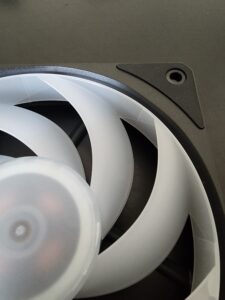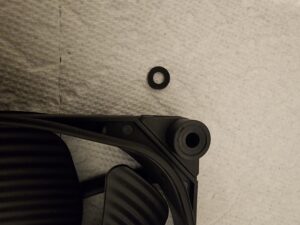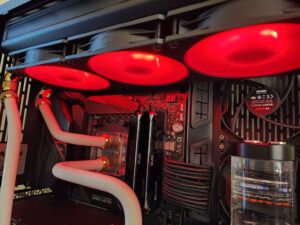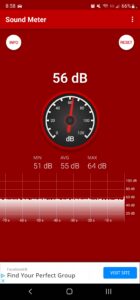The discussion around All-In-One (AIO) CPU coolers versus custom loops will always be ongoing. However, recently there has been a lot of innovation in the AIO market by manufacturers to try to match the performance and customizability of custom loops. Corsair, not to be outdone by its competitors, is launching its next-generation AIO CPU cooler, the iCUE LINK Titan RX RGB. The Titan combines Corsair's latest advancements in cooling engine technology, replaceable pump caps, and iCUE LINK RX120 fans in hopes of being your next CPU cooler.
In addition to the Titan AIO, Corsair supplied me with three of its CapSwap modules. This review will examine the iCUE LINK LCD Screen, VRM Fan, and Pump Cap Groove modules. Is the Titan good enough to topple another AIO I've recently reviewed, the Cooler Master 360 Ion? Continue reading to find out.

Today we will be looking at the brand new 120mm fan offering from Cooler Master, the Mobius 120P ARGB. Founded in 1992, the Taipei based company is a giant in the industry best known for their CPU air coolers and AIO’s, fans, cases, power supplies, and peripherals. Cooler Master was kind enough to send three of their brand new Mobius 120P ARGB fans to ExtremeHW for review. Lets dive in and see what we find.
Key Features
The Mobius 120P ARGB fan is launching at a price of $34.99 USD with availability starting on September 8, 2022. A non-RGB version will also be available with a price of $29.99 USD.
Taking a look at what Cooler Master has to say for the new product here, the Mobius Series represents Cooler Master’s new line of performance fans. Key features include:
- Ring Blade Design (RBD) – Interconnecting fan blades designed for a reinforced structure, eliminating vibration for stable fan rotation
- Pressure Acceleration Air Vents – Angled inner frame rim with chamfered side vents to boost airflow draw while diminishing dead air
- Perfecting Engineering – Sound output finely tuned to optimal sub 6dB prominence noise levels without sacrificing performance
- Luminescent lighting effects – Frosted fan blades enhance light dispersion for a more vibrant and luminescent visual display
- Addressable Gen 2 RGB – Addressable Gen 2 RGB ready for a vast range of versatile customization to your lighting
Specifications

Unboxing
The fan is packaged within a colorful box showing the fan in action. The rear of the box highlights all key features in various languages, while listing all fan specifications and compatibility certifications with various RGB software. Inside the box, the fan is housed within sturdy cardboard packaging with a separate compartment containing the fan cables, and accessories package.
A Closer Look and First Impressions
The Mobius 120P ARGB fan frame feels extremely solid with little to no flex when tested. We do see the ring around the edge that interconnects each fan blade along with a small chamfer on the frame as it meets the fan ring on both sides of the fan.
The fan has two connected cables; the 4-pin PWM connector for power and fan speed control, and the 3-pin ARGB cable which contains both a female and a male connector split from the end of the cable. This should allow you the versatility to use various lighting controllers, ARGB adapters or extensions, or your motherboard’s +5v ARGB header. Cooler Master has thoughtfully provided a solid slightly rubberized cover to protect the pins on the male connector.
Cable Lengths (including connector):
- 4-pin PWM: approximately 11 7/8th inches (302mm)
- 3-pin female ARGB: approximately 12 1/8th inches (308mm)
- 3-pin male ARGB: approximately 15 inches (381 mm)
Within the small accessories package we get the following:
- 4 standard case screws
- Male to male ARGB connector (used for connecting two female ARGB plugs together)
- Plastic housing for ARGB connectors (to protect from bending the pins)
- Small instructional paper showing how to utilize the included male to male connector and housing to connect two female ARGB connectors (Note: We saw two different styles of instructions within our samples)
Looking at the screw mounting points, we see a slightly different approach to anti-vibration dampening then what you see with many competing fan offerings. Where some fans have a rubberized ring around the screw holes, we see here that the fan hole is solid plastic, instead surrounded by a rubberized material on the frame. I can see a durability advantage to this approach by Cooler Master as repeated installations and uninstallations on a BeQuiet Silent Wings 3 fan I have ripped up the small rubberized ring when the screw was removed in a recent uninstall. I don’t foresee that being a problem with Cooler Master’s Mobius 120P.
One thing I noticed right away with both cables is the length. I imagine fan manufacturers are looking for the right balance of not too short and not too long. In my case, I found the PWM cable to be on the short side. The cables barely reached my PWM-splitter cable which plugs into my fan controller. Without that splitter, there was no way these cables would reach the headers on my fan controller where it was mounted in the rear of the case. That said, had I instead opted for any one of the many fan headers included on my motherboard (and using the splitter to install 3 fans to one header), the cable length would be a non-issue. Just keep that in mind if you need to make long runs, you might need an extension.
Another point to mention is the included plastic housing for the ARGB plugs. Due to the design, it could not be used with the adapter cable I used to connect to my fan/lighting controller. Keep this in mind if shopping for adapters.
Whether installing as a case fan, or using on a radiator with some planning around where to plug in the cables, install was otherwise a breeze. Let’s get into the testing!
Test System
The test system we’re using today was build earlier this year with a fully custom water cooling loop giving us a chance to see how these fans perform on radiators.
- AMD Ryzen 9 5900X
- Nvidia GeForce RTX 3080 Ti Founder’s Edition
- Oloy Blade 16GB (2x8GB) DDR4-3600 C14
- ASUS Crosshair VIII Dark Hero
- 2x Samsung 970 Evo Plus 2TB
- Crucial MX500 1TB
- Corsair RM1000X
- Lian Li O11-Dynamic
Notes: We have PBO enabled with a +200MHz offset with auto CO and power settings. The RAM kit is single rank Samsung B-die that has been set to 3733 MHz in a 1:1 ratio with FCLK and tuned timings.
For the watercooling, we are using the following:
- Optimus Foundations AM4 CPU block
- Alphacool Eisblock 3080 Founder’s Edition GPU block
- EK Quantum Kinetic TBE 200 with D5 pump
- Hardware Labs 360GTX and 360GTS radiators
- 14mm white Corsair PMMA tubing with Bitspower fittings
- Mayhems XT-1 Nuke clear coolant
Notes: Unless otherwise stated in the review for sound testing, D5 pump is run at 100% (4800 RPM) speed to ensure maximum flow rate in testing scenarios.
RGB Lighting
You may have noticed I have a system which has a decidedly non-RGB aesthetic. While I personally do not use RGB in my system, I was excited to see how these fans would look.
I first tried a static white and I found it to be very tasteful and in-line with the build aesthetic. I found the lighting to not be distracting as I used the PC with the case on the desk. You can see a small bit of light between the fan frame and the radiator, but the fan design otherwise kept the light pointing down from its position installed on the top mounted radiator.
Given the frosted clear design of the fan blades, I also tried with the RGB turned off. It continues to match my build aesthetic perfectly.
While I was at it, I took a look at various other colors and they all looked fantastic. The lighting controller and software also allowed for various patterns such as waves, rainbow, pulsing, etc. However one should take note of settings within their preferred RGB software. With mine, I found that it sometimes did not take my set lighting profile until I was booted up fully and logged back into Windows, instead defaulting into a rainbow pattern until I was logged in and it could load the set profile. Depending on your software/controller for the ARGB, your experience may be different.
Sound Testing
With comparable fans on hand, I took the opportunity to perform decibel sound testing utilizing the Sound Meter app run on a Samsung S22 Ultra phone. Admittedly, this is not the most scientific method of testing, but still provided good comparable data for evaluating the fans. Each testing run lasted at least 1 minute 10 seconds as logged in the real time running chart via the app.
For the sound testing, I ensured any background sounds were removed. I ran a few scenarios that ranged from all sound producing components within the PC to isolating the 3 Cooler Master Mobius 120P ARGB fans against the 3 BeQuiet Silent Wings 3 High Speed fans as mounted on the top radiator. I also accounted for the D5 pump utilized within the watercooling loop and tested with the pump both on and off.
Sound readings were taken from two locations; sitting at the desk approximately 26 1/2 inches from the PC, and directly in front of the PC.
Note: For max fan speed tests, the Cooler Master Mobius 120P tops out at 2400 RPM while the BeQuiet Silent Wings 3 High Speed tops out at 2200 RPM.
Scenario 1
The goal of this scenario was to measure any difference in sound levels of the full system as one would use it. The two competing setups are:
- 9x BeQuiet Silent Wings 3 High Speed fans (3 intakes, 3 on bottom radiator in pull, 3 on top radiator in push) with D5 pump at 100% speed (4800 RPM)
- 3x Cooler Master Mobius 120P ARGB fans (on top radiator in push) and 6x BeQuiet Silent Wings 3 High Speed fans (3 intakes, 3 on bottom radiator in pull) with D5 pump at 100% speed (4800 RPM)
Measured sitting at desk:
| Fan Speeds | 1000 RPM | 1200 RPM | 1800 RPM | Max Speed |
|---|---|---|---|---|
| 9x SW3 fans with D5 pump | 44 dB | 44 dB | 53 dB | 60 dB |
| 3x CM Mobius fans 6x SW3 fans with D5 pump | 44 dB | 44 dB | 52 dB | 59 dB |
Measured in front of PC:
| Fan Speeds | 1000 RPM | 1200 RPM | 1800 RPM | Max Speed |
|---|---|---|---|---|
| 9x SW3 fans with D5 pump | 45 dB | 45 dB | 54 dB | 61 dB |
| 3x CM Mobius fans 6x SW3 fans with D5 pump | 45 dB | 45 dB | 53 dB | 59 dB |
Scenario 2
The goal of this scenario was to remove the D5 pump from the whole PC sound testing so that the fans would be the only sound measured from the PC.
- 9x BeQuiet Silent Wings 3 High Speed fans (3 intakes, 3 on bottom radiator in pull, 3 on top radiator in push) with D5 pump at 0% speed
- 3x Cooler Master Mobius 120P ARGB fans (on top radiator in push) and 6x BeQuiet Silent Wings 3 High Speed fans (3 intakes, 3 on bottom radiator in pull) with D5 pump at 0% speed
Measured sitting at desk:
| Fan Speeds | 1000 RPM | 1200 RPM | 1800 RPM | Max Speed |
|---|---|---|---|---|
| 9x SW3 fans | 41 dB | 44 dB | 54 dB | 62 dB |
| 3x CM Mobius fans 6x SW3 fans | 39 dB | 42 dB | 51 dB | 60 dB |
Measured in front of PC:
| Fan Speeds | 1000 RPM | 1200 RPM | 1800 RPM | Max Speed |
|---|---|---|---|---|
| 9x SW3 fans | 39 dB | 42 dB | 52 dB | 60 dB |
| 3x CM Mobius fans 6x SW3 fans | 39 dB | 41 dB | 50 dB | 58 dB |
Scenario 3
For the final scenario, we wanted to do a true apples to apples comparison with all other sound producing components removed from the equation.
- 3x BeQuiet Silent Wings 3 High Speed fans (on top radiator in push) with D5 pump at 0% speed
- 3x Cooler Master Mobius 120P ARGB fans (on top radiator in push) with D5 pump at 0% speed
Measured sitting at desk:
| Fan Speeds | 1000 RPM | 1200 RPM | 1800 RPM | Max Speed |
|---|---|---|---|---|
| 3x SW3 fans | 39 dB | 39 dB | 49 dB | 55 dB |
| 3x CM Mobius fans | 37 dB | 38 dB | 45 dB | 55 dB |
Measured in front of PC:
| Fan Speeds | 1000 RPM | 1200 RPM | 1800 RPM | Max Speed |
|---|---|---|---|---|
| 3x SW3 fans | 38 dB | 39 dB | 46 dB | 53 dB |
| 3x CM Mobius fans | 38 dB | 38 dB | 43 dB | 53 dB |
Sound Testing Analysis
The results from the sound testing proved to be very interesting.
Scenario 1 – The fans in either configuration did not add a notable effect to the decibel levels until measured above 1200 RPM. The conclusion here is that the D5 pump within the system, running at 100%, was the primary source of PC noise until fans reached speeds approaching 1500-1800 RPM at which point a measurable increase in decibels was apparent. From both positions, the configuration with the 3 Cooler Master Mobius 120P fans measured below the configuration without them. I also observed that the decibels as measured from sitting at the desk were slightly quieter than those measured in front of the PC. Keep note of this as there were interesting results in the other scenarios’ results. Another observation is at max speed. Despite the Cooler Master Mobius 120P fans having a 200 RPM advantage over the competing Silent Wings 3 High Speed fans, the configuration with the Cooler Master fans measured quieter. Great result for Cooler Master.
Scenario 2 – The D5 pump was removed from the equation. This resulted in a clear reduction in decibel levels at the lower RPM range to being quieter or louder at max speeds when compared to the scenario 1 results, depending on where the measurement was taken. What was definitive is that the configuration with the Cooler Master fans again measured quieter than the competing configuration at all tested RPM ranges. Again, fantastic result for Cooler Master.
Scenario 3 – the D5 pump remained off and 6 fans removed from the equation. This apples to apples comparison resulted in a further reduction in decibel levels throughout each measured level when compared to scenario 2. Once again the Cooler Master configuration proved to be equal or quieter depending on the RPM level. One thing that was different from the previous scenarios was at max fan speeds, both configurations measured equally. Once again, considering the 200 RPM advantage to the Cooler Master fans, this is a great result.
One thing also observed is that once the D5 pump was removed from the equation, the measurement as taken directly in front of the PC was quieter than the one taken from the sitting position. This surprised me, and my theory is that this result is due to the design of the O11-Dynamic case for this test system having a tempered glass front panel with intakes on the side. I suspect a traditional case with front intakes might change the results.
Overall, one thing was clear. The configuration utilizing the Cooler Master Mobius 120P fans proved to be overall quieter.
Temperature Test
Next I wanted to take a look at temperatures while benchmarking. For this test, I opted for Cinebench R23 using the multi-core 30 minute stability test. HWInfo64 was used for temperature monitoring, with the Aquacomputer HighFlow NEXT providing temperature data for the coolant. Ambient temperature was approximately 72F (22.2C) for both runs, however this was the temperature as set by the thermostat. I would estimate that there could be a variation of +/- 1C in the testing environment. Please keep this in mind when revieing the data. There was at least 2 hours between the two testing runs both as a result of the need to teardown and switch fans on the radiator, but also to ensure the environment around the PC could return to a stable ambient temperature for the next run.
Note: All fans were run at 100% max RPM. Please recall that the Silent Wings 3 High Speeds top out at 2200 RPM while the Cooler Master Mobius 120P fans top out at 2400 RPM.
To recap the two competing configurations:
- 9x BeQuiet Silent Wings 3 High Speed fans (3 intakes, 3 on bottom radiator in pull, 3 on top radiator in push) with D5 pump at 100% speed (4800 RPM)
- 3x Cooler Master Mobius 120P ARGB fans (on top radiator in push) and 6x BeQuiet Silent Wings 3 High Speed fans (3 intakes, 3 on bottom radiator in pull) with D5 pump at 100% speed (4800 RPM)
| Fans | 9x SW3 fans | 3x CM Mobius fans, 6x SW3 fans |
|---|---|---|
| Coolant Temperature | 29.69C | 29.26C |
| CPU Temperature Avg. | 76.35C | 72.63C |
Temperature Testing Analysis
From the results, the coolant temperature reading is comparable between runs. However there is a sizeable 3.72C degree difference in average CPU temperature between the two runs. Accounting for a potential variation in ambient, we still see the Cooler Master Mobius 120P configuration edging out the Silent Wings 3 setup. Again, great results for Cooler Master.
Conclusion
The new Mobius 120P ARGB fans from Cooler Master are a compelling offering with solid performance numbers in both cooling capabilities and sound testing. The fans are solid in construction and well featured with a good accessory package for those wanting to make use of the ARGB features. The RGB lighting looks great without being overly distracting. Pricing for both non-RGB and ARGB versions seems reasonable within the current fan market and competition. If I had any comments to give Cooler Master, I would consider a slightly longer PWM cable and maybe a different style of housing for the ARGB connectors for greater compatibility with various ARGB adapters or extension cables one may use with the fans ARGB connectors.
| Pro's | Con's |
|---|---|
| Cooling Performance / Airflow | 4-pin PWM cable length on the short side |
| Sound levels | Plastic housing for ARGB connectors could be redesigned to allow great compatibility |
| Quality construction | |
| Accessories package | |
| ARGB lighting |

Want to discuss this product or give your views and feedback from your own usage? Discuss on the ExtremeHW Forums
Like our content? Please consider Donating to help us to continue our writing.
This Post Has 8 Comments
Leave a Reply
You must be logged in to post a comment.

































Very well done article Sir B! In depth and comprehensive. Very cool that they managed to beat out your SW3’s, I was not expecting that. Looking forward to more reviews from you!
Thanks Avacado! This was a lot of fun to do and I was likewise surprised by the results. Definitely looking forward to more!
Very well done. Your review made me want those fans, bro.
Thanks for reading!
Amazing review. Very thorough. Much wow! On a serious note, it sounds like Cooler Master really knocked it out of the park with these fans. Sounds like they’re worth every bit of their MSRP. Not too bad looking either, I mean fans look like fans, but those really look pretty slick even with the RGB’s off. I might consider these in a future build if they’re still available on my next build!
Thanks for reading Pio!
Great review. I am planning to buy Cooler Master HAF 700 EVO + 12 Mobius 120P ARGB fans. Could you please advise on how did you connect these fans? was it directly to a motherboard or using a hub/controller? if yes which one? As far as I am aware you can buy them as 1 pack – single fan rather then pack of 3. Many thanks !
Thanks for reading! I used an Aquacomputer Octo fan controller and controlled these via Aquasuite. My samples came as individual 1-packs. I am not aware of any 3-pack offerings currently.